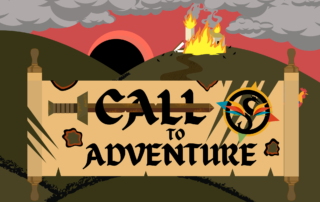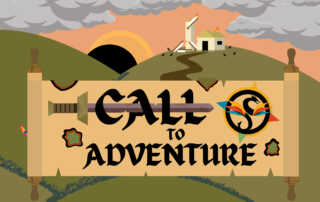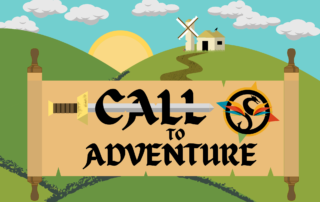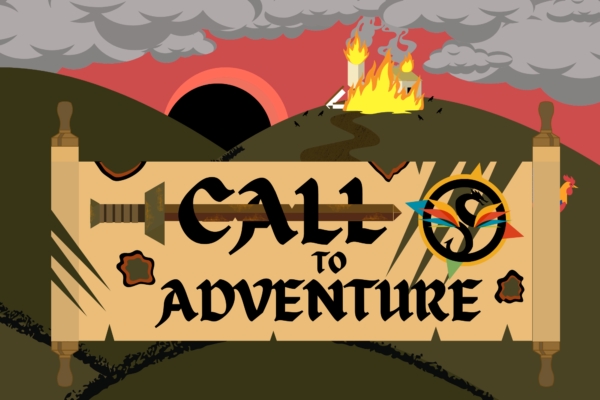
Chapter 5: Have Leather, Will Travel
You and your companion march onward to Castor. Based on the signs you pass by on the road, you are only two days away from reaching the front gates of the city. Minus the multitudes of distractions that kept you from reaching your destination, you have not actually seen the dragon since you left the farm several days ago. You slow down and stop in the middle of the road. Looking up at the sky, you wonder if you even need to warn anyone at Castor. What if the Dragon flew off to a distant land away from the county? What if it decided to repent and become a peaceful, non-destructive dragon determined to spread joy and happiness to the world? What if it decides to find another dragon and start a family of peaceful, fun-loving dragons that blow bubbles instead of fire? What if it just wants a friend? These thoughts keep you up at night.
A dove flies above you, giving you a bit of peace.
Suddenly, a roar rips through the valley.
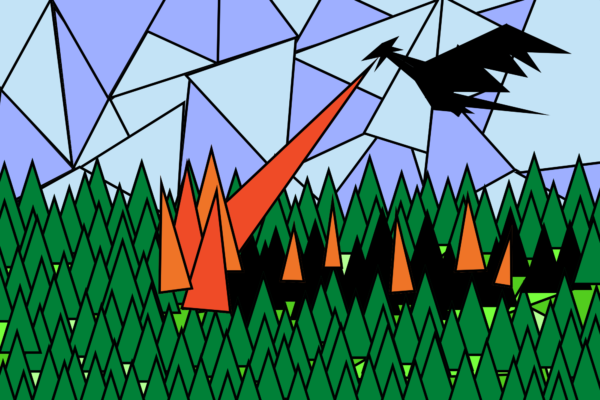
The massive, dark shadow of the Dragon flies overhead and blows a river of fire across the forest ahead of you, destroying everything in its path. The dove you saw earlier flies near the beast’s tail. From the corner of its eye, the Dragon sees the symbol of peace and hope, snarls, and whips its tail at the innocent creature. The dove disappears in a puff of feathers. The monster makes a final triumphant roar and flies away.
So much for peace, love, and happiness.
You and the rooster look at each other and realize that with the Dragon as close as it is, it will only be a matter of time before it reaches Castor. However, even if you decide to run to Castor, you will unlikely reach the city on time.
You fall to your knees in disbelief. You failed your quest.
Just as you fall into despair, the words “Continue: Yes or No?” pop up in your head. Humoring your grief-driven insanity, you answer “Yes” in your head. The words “1-Up” shows up in your mind, and the sound of hooves echoes behind you. You turn around, wondering if you really have lost your mind and are starting to hear things.
A horse-drawn wagon stops behind your party and a young individual clad in intricate leather armor dismounts and looks at you. They remove their helmet, and their silvery hair flows down to their shoulders. She has silver eyes and slightly pointed ears. Based on her ears, lithe features, and masterfully crafted leather equipment, you realize she is a wood elf.
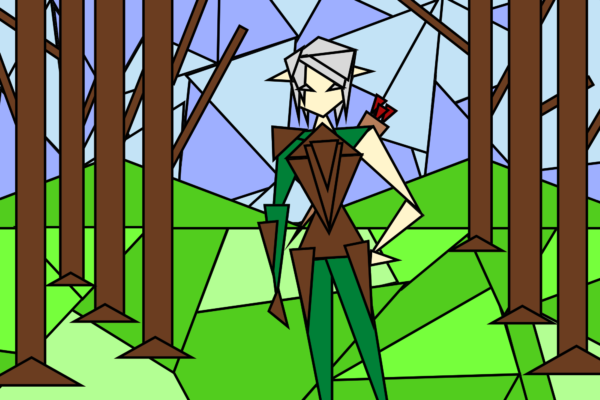
“Hello, human. Are you taking a break from your hunt?” she asks.
You stare confusedly at her.
“Are you not a Hunter from the Adventurer’s Guild? You are following the trail of destruction left by the Scorchbearer, no?
You explain that you are not a member of the Guild and are trying to warn Castor of the Dragon after it destroyed your home. You give the elf a summarized version of your journey, from fighting your enemy-turned-ally, the Rooster, dealing with a mad wizard, discovering the Lake Nest Monster, stopping a horde of goblins in the mines, and brokering peace between two forest factions. You also tell her of your failure to reach Castor on time before its inevitable destruction.
She crouches down to your level, puts a hand on your shoulder, and smiles.
“The town is not destroyed yet, no? Scorchbearer – or Dragon, as your kind calls it – does not destroy mindlessly. It is an intelligent creature. It burns bridges, garrison towns, trade routes, and farms, preventing the largest population center in the region from receiving food, aid, and supplies. Even if it fails to destroy Castor and the Guild by fire, it will destroy Castor and the Guild through starvation and disease.”
You look at her in disbelief. How could that possibly be better news?
“While I speak of dark times, there is hope. Castor is a well-defended town and will survive the fire, but only if the Scorchbearer is stopped before it reaches the Great Bridge, the only remaining trade route connecting the city to other trade centers in the region. If trade flows into the city, it will survive.”
You ask her if she knows anyone who can stop the Dragon. With the only Hunters available at the Guild, you cannot think of anyone else who would be capable of stopping the creature.
The elf looks at you confusedly.
“Again I ask: are you not a Hunter? You are not a member of the Guild, but you have had more Guild experience than half of its members. Most Guild Hunters slay simple creatures like slimes and giant rats. However, what you lack in physical strength, you make up for in skill, intelligence, and survival skills.”
You laugh nervously, explaining you are not equipped to fight a world-ending monster.
She picks up your bag nearby and peers at the contents within. She pulls out some of the traveling supplies and tosses them out. As you are about to say something, she freezes. She stares at the remaining items in the bag, and her eyes widen. She closes the bag, tosses it back at you, and smiles.
“You are more than equipped, Hunter.”
She grabs your hood and yanks you up.
“Come. We have one day to get to the Great Bridge, and we have much to prepare. I am Serena, an apprentice artisan of the Corvus Elf Clan. They were destroyed decades ago by the Scorchbearer. I have honed my craft to prepare armor worthy of the Hunter who will defend these lands from the creature. You are that Hunter. May I accompany you on your quest?”
She holds her arm out in front of you.
If Castor is destroyed, the county will fall to raiders and disease. You will most likely not survive the coming winter. If you fight the Dragon, you will most likely not survive the coming sunrise.
You have a one percent chance of surviving tomorrow, but you have a zero percent chance of surviving at the end of this season. You have nothing to lose, so you decide that you may as well go down fighting.
You grab Serena’s forearm and agree to add her to your party. The words “Companion Unlocked” and “New Profession Unlocked: Novice Hunter” pop up in your brain, causing you to smile despite the concerning levels of word-based hallucinations you have been experiencing as of late.
Serena smiles.
“Excellent. We will gather the bare necessities from my wagon and leave it behind with any supplies we do not need for the journey. The magical locks will keep its contents from being stolen by bandits. Then, we shall take my horse and ride to the Great Bridge.”
She walks to the cabin door of her wagon and enters. You follow closely behind. The inside of the wagon has shelves packed with leather of different shapes and sizes. The small workbench is severely disorganized, with bits of cord, leather scraps, and tools strewn about.
The elf throws aside some pelts in the corner and pulls out a small chest from beneath.
“Pass me your bronze dagger, please.”
You hand her your dagger. She looks near the hilt and points at the underside of the crossguard. You see a small, winged serpent underneath. It is a dragon.
She looks at the chest, which has the same symbol near the lock.
“Long ago, four civilizations to the south lived together in harmony. Then, everything changed when a fire drake attacked. Only a brave knight, lord of the four civilizations, could stop it. But when the nation needed him most, he vanished. A hundred years passed, and my master and I discovered the knight’s loot chest, which is packed with the equipment needed to remake his fireproof armor. Although my crafting skills are great, I have a lot to learn about locksmithing before I can open this for anyone. But I believe you can save the world…if you use that key.”
She points at the dagger.
You unsheathe the dagger and stick it in the keyhole at the front of the chest. It fits perfectly. You pull the dagger out, and the hole glows slightly. Serena grimaces.
“It seems the knight was a fan of using wealth-based magic to open his loot chests. Try inserting a gold coin inside of the keyhole now.”
You pull out a gold round from your pouch and insert it into the keyhole. The chest makes a strange sound, seeming to approve of our small transaction.
The elf opens the chest and rummages through it. She pulls out a scaled hide, similar in texture to a lizard. However, each scale seems to have the texture of a metal plate.
“Incredible! This is a drake hide! Light as cloth but tougher than any forged steel made by humans. What makes it even more unique will be to your advantage: it is fireproof.”
She pulls out some razor-sharp shears and other crafting equipment from inside the chest.
“These must be the only tools capable of preparing this leather. They are of dwarven design and are incredibly well-made. Please give me a moment.”
She turns to her workbench and gets to work. She cuts, hammers, and sews faster than any craftsman you have ever seen. In a few minutes, she creates a full set of drakeskin armor, which she hands to you.
You try it on. It fits you perfectly and does not hinder your movement. You feel significantly safer in the armor than you did in your old farmhand clothes.
She takes your cloak and lines the outside with some of the remaining drake hides. She gives it back to you, and you put it on. She beams proudly at her work.
“While this armor will not protect you from being eaten alive, it should save you from minor physical damage and give you complete fire protection. Your cloak is also fireproof, so you should be able to use it as a shield from the Scorchbearer’s flames.”
You ask her how she made such an amazing piece in such a short amount of time.
“I am but an apprentice and no older than yourself in elven years. I have lived for over 150 years, but I am not a master of my craft. What I made you is a passable piece that can be improved with more time. However, I will take this as a learning experience. My master, Edom Ande, always said such wise words about mistakes: ‘I never look back, darling. It distracts from the now.’ “
You do not question the words of a wise crafter of hero armor and ask Serena what is next.
“Now, we are going to meet some of my friends near the Great Bridge. Every hero needs a monster-slaying weapon, and they are the greatest blacksmiths in the region. Quickly! Get on my horse!”
Your party mounts the great steed, and the elf removes the straps of leather connecting him to the wagon.
“Run, Lightmail! Show us the meaning of speed!”
The horse neighs and bolts down the path toward the Great Bridge. The end is coming. The Dragon awaits.
History of Armor:
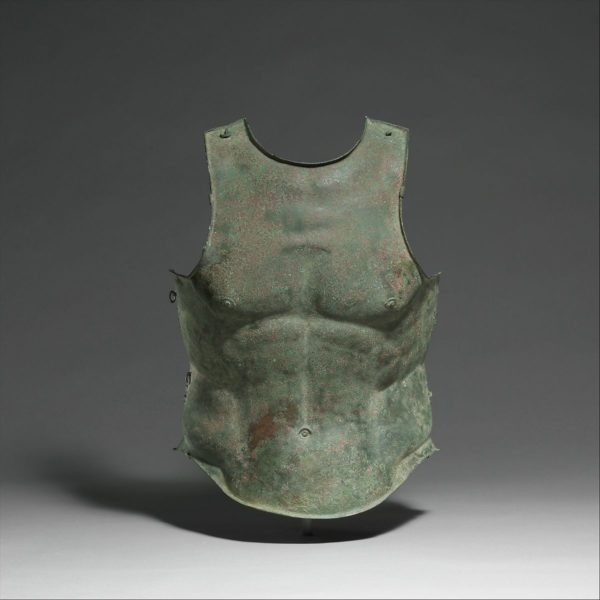
Many civilizations developed armor for their soldiers and warriors to protect them from all manner of harm, including arrows, blades, and blunt weapons. Prehistoric warriors often used reinforced leather hides to make helmets and clothing for protection. Over the years, different civilizations developed various styles of armor to counter weapons used by their enemies. In ancient Greece, Spartan soldiers were famous for their abilities in battle. They used bronze breastplates, helmets, shin guards, and shields to protect them from arrows, spears, and swords, which – at the time – were made with materials that could not cut through the heavy armor. However, the weight and cost of the armor caused it to fall out of favor with later civilizations, like the Romans, who preferred to balance protection, cost, and weight. Most militaries adopted chainmail armor, which is made of rings of connected metal that is formed into a fabric-like material. This armor was flexible, lighter, and could still protect a soldier from slashing attacks from swords. However, they were ineffective against piercing weapons, like lances and spears. In the 12th and 13th centuries, medieval knights used mail, a combination of steel chainmail sewed on leather or thick fabric. This was layered on top of a gambeson, a quilted garment that added a layer of protection and padding for the warrior. While better than chainmail, mail still lacked the protection needed to protect a knight completely. In the 14th century, developments in technology allowed plate armor to be made, with interconnected pieces of forged steel designed to cause all manner of weapons to glance harmlessly off the knight.
 While this armor was used well into the 17th century, the production of firearms forced armorers to make thicker and heavier armor, which became impractical by the 18th century. With armies preferring mobility over protection, the armor was largely abandoned until the development of modern bulletproof armor that we see today.
While this armor was used well into the 17th century, the production of firearms forced armorers to make thicker and heavier armor, which became impractical by the 18th century. With armies preferring mobility over protection, the armor was largely abandoned until the development of modern bulletproof armor that we see today.
Take-and-Make Information:
Have you wanted to become the hero of your own story? Then join the Adventurer’s Guild! We will provide you with the tools you need to survive in any situation! This month, we explored the topic of Armor, learning about how people throughout history protected themselves in battle – from simple leather to heavy plate! Pick up your “Adventurer’s Guild Bracer/Arm-Guard” Take-and-Make* at the La Plata Branch Library from one of our master crafters at the front desk.
Unfortunately, our resident leatherworker has forgotten the process of making leather, so you will have to tell them the main ingredient needed to turn animal hide into a piece of leather. They will give you a kit once you jog their memory.
Here’s a hint: It’s big, yellow, and only shows up when the moon is gone…
Supplies are limited, so pick up your kit today!
*Disclaimer: The local Crafters Guild has not approved these bracers for use in battle. A Dwarven Quality Control Council Member came in to inspect these for effectiveness but gave the Seal of Approval after looking at a prototype for a few seconds and getting distracted by a particularly well-made bronze wind chime. The Adventurer’s Guild is aware of the Dwarven Quality Control Council’s expired license and has sent several reminders for them to renew it before approving equipment for public use.

